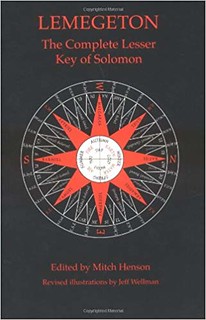
Another grimoire attributed to Solomon is the Lemegeton, or Lesser Key of Solomon. The origin and meaning of Lemegeton are not known. The book also was known as Liber Spirituum and Liber Officiorum. Claims were made that the Lemegeton was originally written in Chaldean and Hebrew, but these are doubtful. The earliest perfect examples of it are in French. The material probably is derived in part from the Testament of Solomon and also the apochryphal book of Enoch. Part of the Lemegeton was published in Latin by the Demonologist Johann Weyer in 1563, entitled Pseudomonarchia Daemonum (Pseudo- monarchy of Demons). Reginald Scot translated part of it into his Discoverie of Witchcraft (1584).
 The book is divided into four parts: Goetia, Theurgia, the Pauline Art, and the Almadel. The Almadel was mentioned in writing around 1500. Goetia is devoted to evil spirits. Theurgia (or Theurgia-Goetia, as it is also called) is devoted to both good and evil spirits and all aerial spirits. The Pauline Art concerns the spirits who govern the planets, the signs of the zodiac, and the hours of the day and night. The Almadel concerns 20 chief spirits who govern the four quarters and the 360 degrees of the zodiac. Goetia is the part published by Weyer. Waite speculated that Goetia is the original Lemegeton and the other three parts were unknown to Weyer and were added at a later time.
The book is divided into four parts: Goetia, Theurgia, the Pauline Art, and the Almadel. The Almadel was mentioned in writing around 1500. Goetia is devoted to evil spirits. Theurgia (or Theurgia-Goetia, as it is also called) is devoted to both good and evil spirits and all aerial spirits. The Pauline Art concerns the spirits who govern the planets, the signs of the zodiac, and the hours of the day and night. The Almadel concerns 20 chief spirits who govern the four quarters and the 360 degrees of the zodiac. Goetia is the part published by Weyer. Waite speculated that Goetia is the original Lemegeton and the other three parts were unknown to Weyer and were added at a later time.
The Lemegeton lists 72 Fallen Angels, their titles, seals, duties, and powers, and the angels who can thwart them. The number 72 may have been inspired by the Schemhamphorae, 72 angels who bear the Names of God, which are given in Hebrew Scripture and are expressed at the end of every verse. The verses are used in invocation and in magic. The Schemhamphorae function as names of power. The 72 Demons in the Lemegeton possess teaching skills for the sciences and art, as well as the ability to cause terrible diseases and disasters. Few have any healing ability.